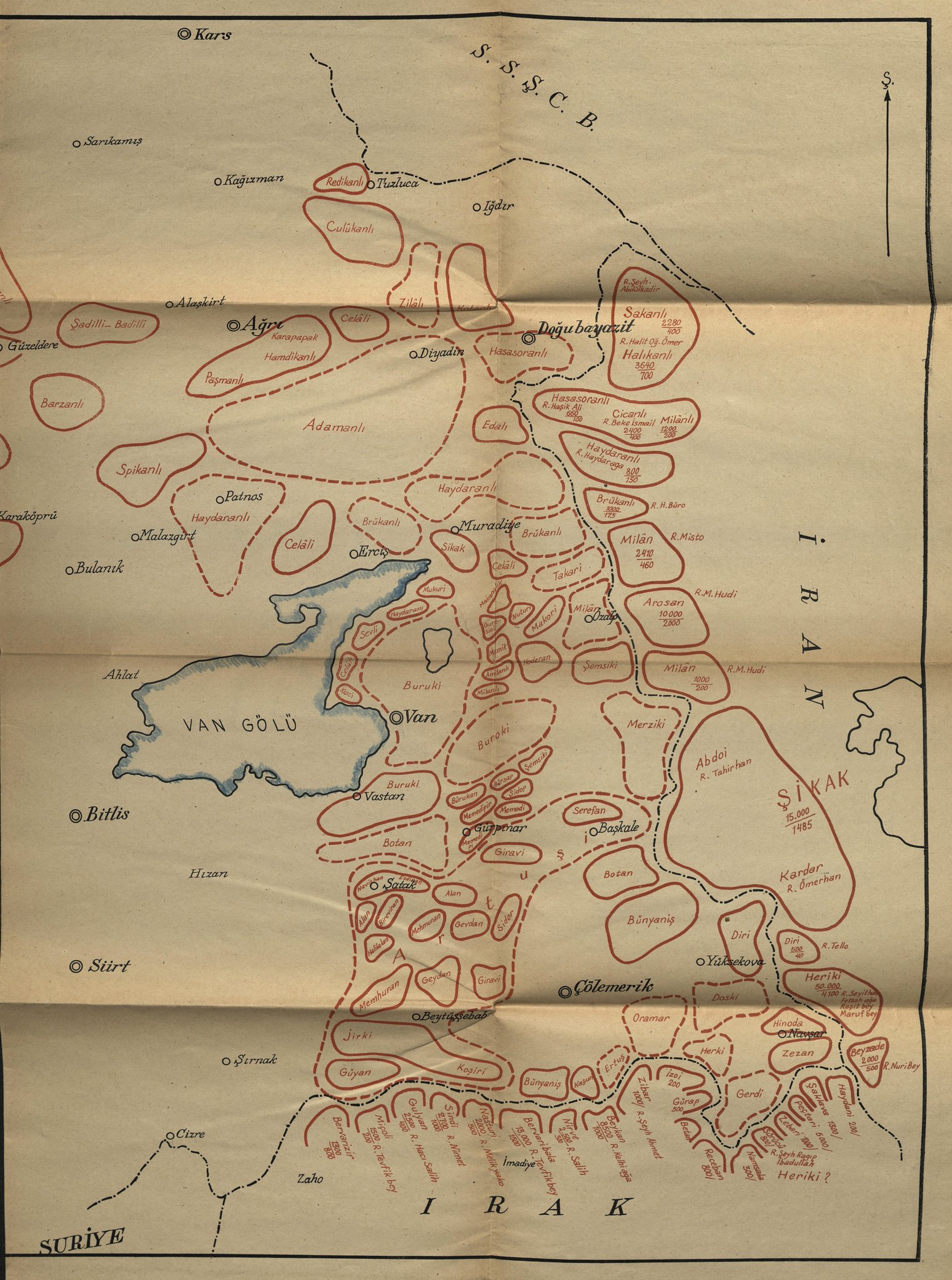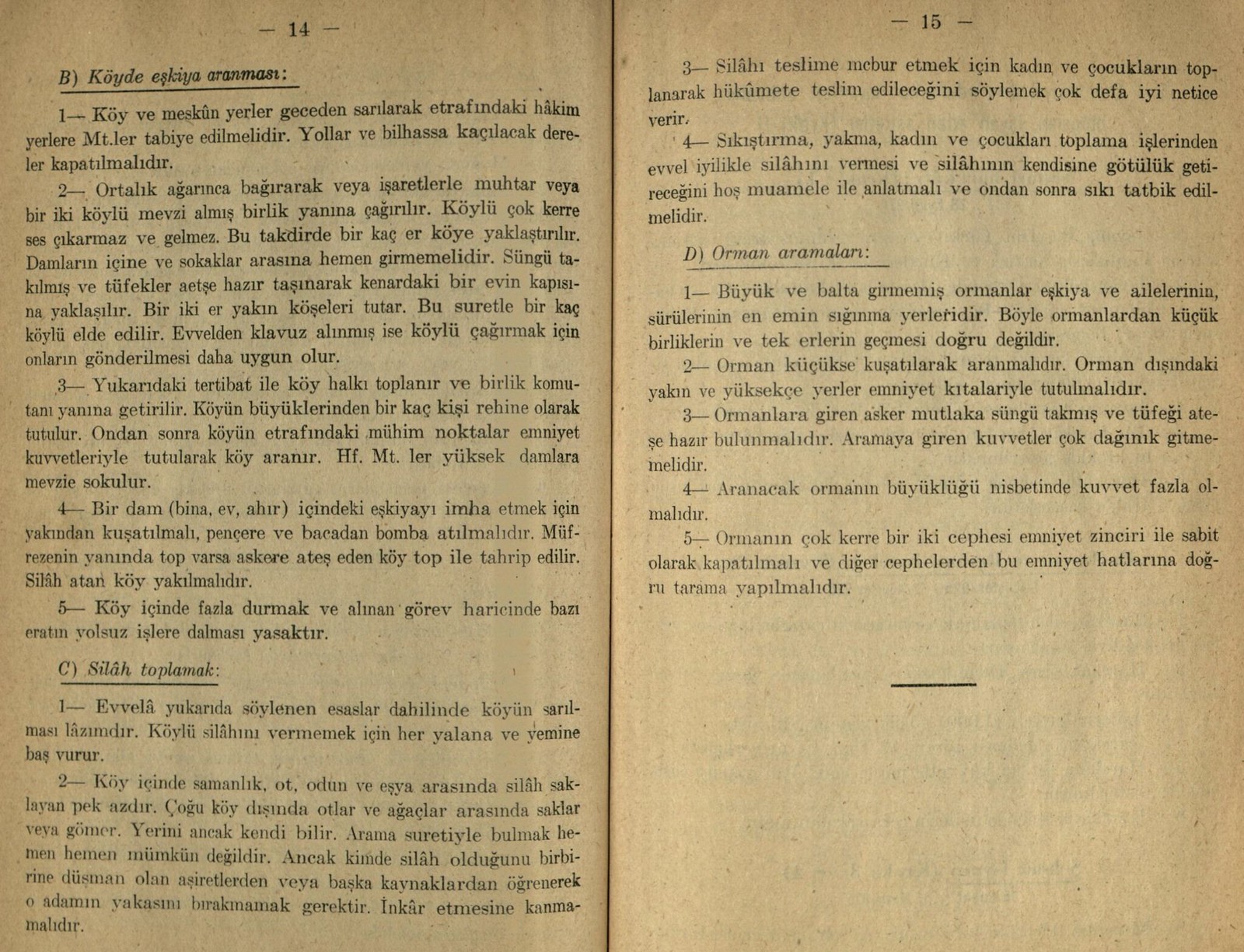(See a full-size version of this map can be found here, along with the map's western half, showing Dersim, here. Another map in the book's appendix shows the various rebellions featured in the text.)
Today's map today comes from a book entitled "Doğu bölgesindeki geçmiş isyanlar ve alınan dersler" or "Rebellions that have taken place in the Eastern region and their lessons," published in 1946 by the Turkish General Staff. The legend explains that tribes marked in dotted red lines are "those who have been involved in rebellions up until the present" while tribes in solid red are "those not involved in rebellions up until the present." Phrased like this, of course, it's hard to avoid the implication that for the other still docile tribes it could just be a matter of time. Indeed, one of the more interesting points that comes out of Reşat Kasaba's Moveable Empire is that the Ottoman state's efforts to break the power of Eastern Anatolian tribes were hobbled by a fundamental contradiction: in fighting rebellious tribes the state relied on the support of loyal tribes, which where thereby strengthened through their alliance with the state and the removal of their tribal rivals. In this context it is interesting to read in Ümit Üngör's Making of Modern Turkey that while the Republican government certainly relied on tribal allies in fighting rebellions in the 20s and 30s, it also distinguished itself from the Ottoman state in its willingness to deport members of even loyal tribes from Eastern Anatolia.
"Doğu bölgesindeki geçmiş isyanlar ve alınan dersler" itself is largely devoted to straightforward military advice for fighting a guerrilla war, covering such topics as scouting, defensive measures in bad terrain and avoiding ambushes. The conclusion also features a brief summary of the major rebellions the Turkish Army faced, almost all of which are attributed to British intrigue. Perhaps most striking today is the section below, concerning treatment of local villages. Today there are still many scholars doing important work in publicizing the brutality of the Turkish state during the one-party era, yet at the same time there are others for whom it seems casual and often insufficiently contextualized attacks on Kemalist authoritarianism have become an end in themselves. In this context I would only say that I highlight the passage below not to suggest that the Turkish military was doing anything that any other army facing an insurgency in the 20th century didn't, but rather because the manual's remarkable candor should help force us to confront the kind of systematic violence that far too many people continue to suffer in civil wars around the world. A translation of the text appears below.
B) Searching for bandits in a village
1. The village and inhabited areas should be surrounded at night and mechanized guns should be placed around it in commanding locations. Roads and especially stream beds through which escapes could occur must be closed.
2. As dawn breaks the muhtar [village headman] or one or two villagers should be called to the unit’s position by means of shouting or signals. Generally villagers remain silent and do not come. In this case a few soldiers should be sent toward the village. They should not immediately enter the structures or between the streets. With bayonets mounted and guns ready to fire they approach the door of an outer house. One or two soldiers cover the corners. In this manner a few villagers are obtained. If a guide has earlier been obtained, sending him to obtain villagers is more suitable.
3. In the aforementioned manner the village’s population is gathered and brought to the unit’s commander. A few from among the village notables are taken as hostages. After that the village is searched while the important positions around the village are covered by a security force. Light mechanized guns are positioned on high roofs.
4. To destroy bandits located indoors (buildings, houses, stables) these structures should be approached and bombs should be thrown in the windows or down the chimneys. If the detachment has artillery, villages firing on soldiers should be destroyed with the artillery. Villages opening fire should be burned.
5. It is forbidden for soldiers to remain unnecessarily within the village for anything other than what is ordered and to engage in corrupt business.
C) Gathering weapons
1. It is necessary to surround the village according to the principles stated above. Villagers resort to every lie and promise to avoid giving up their guns.
2. Those hiding their guns in hay, feed, wood or belongings within the village are few. Most hide and bury their guns in fields and forests outside the village. They are almost impossible to find through searching. Rather those who have weapons must be identified from rival tribes or other sources and then pressured. Their denials must not be believed.
3. Often gathering their wives and children and saying they will be handed over to the government is effective in forcing them to surrender their guns.
4. Before pressuring, burning or gathering women and children, positive means should be used to secure weapons. It should be explained in a friendly manner that guns will bring their owners trouble and this should then be made certain.
Nick Danforth, Georgetown University
Today's map today comes from a book entitled "Doğu bölgesindeki geçmiş isyanlar ve alınan dersler" or "Rebellions that have taken place in the Eastern region and their lessons," published in 1946 by the Turkish General Staff. The legend explains that tribes marked in dotted red lines are "those who have been involved in rebellions up until the present" while tribes in solid red are "those not involved in rebellions up until the present." Phrased like this, of course, it's hard to avoid the implication that for the other still docile tribes it could just be a matter of time. Indeed, one of the more interesting points that comes out of Reşat Kasaba's Moveable Empire is that the Ottoman state's efforts to break the power of Eastern Anatolian tribes were hobbled by a fundamental contradiction: in fighting rebellious tribes the state relied on the support of loyal tribes, which where thereby strengthened through their alliance with the state and the removal of their tribal rivals. In this context it is interesting to read in Ümit Üngör's Making of Modern Turkey that while the Republican government certainly relied on tribal allies in fighting rebellions in the 20s and 30s, it also distinguished itself from the Ottoman state in its willingness to deport members of even loyal tribes from Eastern Anatolia.
"Doğu bölgesindeki geçmiş isyanlar ve alınan dersler" itself is largely devoted to straightforward military advice for fighting a guerrilla war, covering such topics as scouting, defensive measures in bad terrain and avoiding ambushes. The conclusion also features a brief summary of the major rebellions the Turkish Army faced, almost all of which are attributed to British intrigue. Perhaps most striking today is the section below, concerning treatment of local villages. Today there are still many scholars doing important work in publicizing the brutality of the Turkish state during the one-party era, yet at the same time there are others for whom it seems casual and often insufficiently contextualized attacks on Kemalist authoritarianism have become an end in themselves. In this context I would only say that I highlight the passage below not to suggest that the Turkish military was doing anything that any other army facing an insurgency in the 20th century didn't, but rather because the manual's remarkable candor should help force us to confront the kind of systematic violence that far too many people continue to suffer in civil wars around the world. A translation of the text appears below.
B) Searching for bandits in a village
1. The village and inhabited areas should be surrounded at night and mechanized guns should be placed around it in commanding locations. Roads and especially stream beds through which escapes could occur must be closed.
2. As dawn breaks the muhtar [village headman] or one or two villagers should be called to the unit’s position by means of shouting or signals. Generally villagers remain silent and do not come. In this case a few soldiers should be sent toward the village. They should not immediately enter the structures or between the streets. With bayonets mounted and guns ready to fire they approach the door of an outer house. One or two soldiers cover the corners. In this manner a few villagers are obtained. If a guide has earlier been obtained, sending him to obtain villagers is more suitable.
3. In the aforementioned manner the village’s population is gathered and brought to the unit’s commander. A few from among the village notables are taken as hostages. After that the village is searched while the important positions around the village are covered by a security force. Light mechanized guns are positioned on high roofs.
4. To destroy bandits located indoors (buildings, houses, stables) these structures should be approached and bombs should be thrown in the windows or down the chimneys. If the detachment has artillery, villages firing on soldiers should be destroyed with the artillery. Villages opening fire should be burned.
5. It is forbidden for soldiers to remain unnecessarily within the village for anything other than what is ordered and to engage in corrupt business.
C) Gathering weapons
1. It is necessary to surround the village according to the principles stated above. Villagers resort to every lie and promise to avoid giving up their guns.
2. Those hiding their guns in hay, feed, wood or belongings within the village are few. Most hide and bury their guns in fields and forests outside the village. They are almost impossible to find through searching. Rather those who have weapons must be identified from rival tribes or other sources and then pressured. Their denials must not be believed.
3. Often gathering their wives and children and saying they will be handed over to the government is effective in forcing them to surrender their guns.
4. Before pressuring, burning or gathering women and children, positive means should be used to secure weapons. It should be explained in a friendly manner that guns will bring their owners trouble and this should then be made certain.
Nick Danforth, Georgetown University






